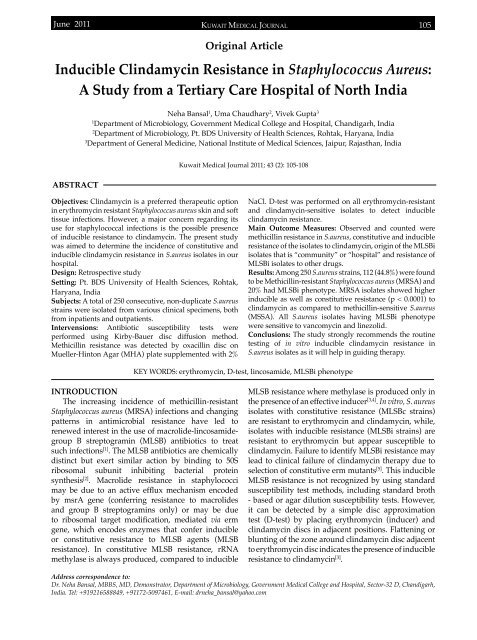Vol 43 # 2 June 2011 - Kma.org.kw
Vol 43 # 2 June 2011 - Kma.org.kw
Vol 43 # 2 June 2011 - Kma.org.kw
You also want an ePaper? Increase the reach of your titles
YUMPU automatically turns print PDFs into web optimized ePapers that Google loves.
<strong>June</strong> <strong>2011</strong><br />
KUWAIT MEDICAL JOURNAL 105<br />
Original Article<br />
Inducible Clindamycin Resistance in Staphylococcus Aureus:<br />
A Study from a Tertiary Care Hospital of North India<br />
Neha Bansal 1 , Uma Chaudhary 2 , Vivek Gupta 3<br />
1<br />
Department of Microbiology, Government Medical College and Hospital, Chandigarh, India<br />
2<br />
Department of Microbiology, Pt. BDS University of Health Sciences, Rohtak, Haryana, India<br />
3<br />
Department of General Medicine, National Institute of Medical Sciences, Jaipur, Rajasthan, India<br />
Kuwait Medical Journal <strong>2011</strong>; <strong>43</strong> (2): 105-108<br />
ABSTRACT<br />
Objectives: Clindamycin is a preferred therapeutic option<br />
in erythromycin resistant Staphylococcus aureus skin and soft<br />
tissue infections. However, a major concern regarding its<br />
use for staphylococcal infections is the possible presence<br />
of inducible resistance to clindamycin. The present study<br />
was aimed to determine the incidence of constitutive and<br />
inducible clindamycin resistance in S.aureus isolates in our<br />
hospital.<br />
Design: Retrospective study<br />
Setting: Pt. BDS University of Health Sciences, Rohtak,<br />
Haryana, India<br />
Subjects: A total of 250 consecutive, non-duplicate S.aureus<br />
strains were isolated from various clinical specimens, both<br />
from inpatients and outpatients.<br />
Intervensions: Antibiotic susceptibility tests were<br />
performed using Kirby-Bauer disc diffusion method.<br />
Methicillin resistance was detected by oxacillin disc on<br />
Mueller-Hinton Agar (MHA) plate supplemented with 2%<br />
NaCl. D-test was performed on all erythromycin-resistant<br />
and clindamycin-sensitive isolates to detect inducible<br />
clindamycin resistance.<br />
Main Outcome Measures: Observed and counted were<br />
methicillin resistance in S.aureus, constitutive and inducible<br />
resistance of the isolates to clindamycin, origin of the MLSBi<br />
isolates that is “community” or “hospital” and resistance of<br />
MLSBi isolates to other drugs.<br />
Results: Among 250 S.aureus strains, 112 (44.8%) were found<br />
to be Methicillin-resistant Staphylococcus aureus (MRSA) and<br />
20% had MLSBi phenotype. MRSA isolates showed higher<br />
inducible as well as constitutive resistance (p < 0.0001) to<br />
clindamycin as compared to methicillin-sensitive S.aureus<br />
(MSSA). All S.aureus isolates having MLSBi phenotype<br />
were sensitive to vancomycin and linezolid.<br />
Conclusions: The study strongly recommends the routine<br />
testing of in vitro inducible clindamycin resistance in<br />
S.aureus isolates as it will help in guiding therapy.<br />
KEY WORDS: erythromycin, D-test, lincosamide, MLSBi phenotype<br />
INTRODUCTION<br />
The increasing incidence of methicillin-resistant<br />
Staphylococcus aureus (MRSA) infections and changing<br />
patterns in antimicrobial resistance have led to<br />
renewed interest in the use of macrolide-lincosamidegroup<br />
B streptogramin (MLSB) antibiotics to treat<br />
such infections [1] . The MLSB antibiotics are chemically<br />
distinct but exert similar action by binding to 50S<br />
ribosomal subunit inhibiting bacterial protein<br />
synthesis [2] . Macrolide resistance in staphylococci<br />
may be due to an active efflux mechanism encoded<br />
by msrA gene (conferring resistance to macrolides<br />
and group B streptogramins only) or may be due<br />
to ribosomal target modification, mediated via erm<br />
gene, which encodes enzymes that confer inducible<br />
or constitutive resistance to MLSB agents (MLSB<br />
resistance). In constitutive MLSB resistance, rRNA<br />
methylase is always produced, compared to inducible<br />
MLSB resistance where methylase is produced only in<br />
the presence of an effective inducer [3,4] . In vitro, S. aureus<br />
isolates with constitutive resistance (MLSBc strains)<br />
are resistant to erythromycin and clindamycin, while,<br />
isolates with inducible resistance (MLSBi strains) are<br />
resistant to erythromycin but appear susceptible to<br />
clindamycin. Failure to identify MLSBi resistance may<br />
lead to clinical failure of clindamycin therapy due to<br />
selection of constitutive erm mutants [5] . This inducible<br />
MLSB resistance is not recognized by using standard<br />
susceptibility test methods, including standard broth<br />
- based or agar dilution susceptibility tests. However,<br />
it can be detected by a simple disc approximation<br />
test (D-test) by placing erythromycin (inducer) and<br />
clindamycin discs in adjacent positions. Flattening or<br />
blunting of the zone around clindamycin disc adjacent<br />
to erythromycin disc indicates the presence of inducible<br />
resistance to clindamycin [3] .<br />
Address correspondence to:<br />
Dr. Neha Bansal, MBBS, MD, Demonstrator, Department of Microbiology, Government Medical College and Hospital, Sector-32 D, Chandigarh,<br />
India. Tel: +919216588849, +91172-5097461, E-mail: drneha_bansal@yahoo.com
















